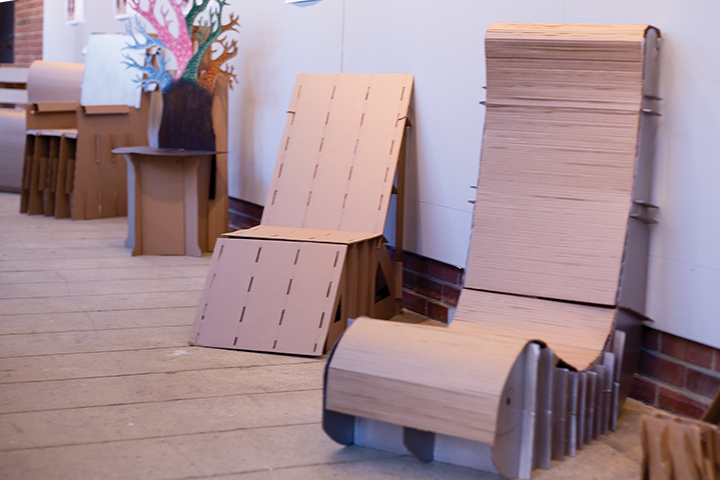
Linear Gallery in the Architecture Building
Architecture usually inspires images of permanent structures made from concrete, glass or wood. But one class has challenged this notion by constructing chairs made from an unconventional material: cardboard.
University professor Madlen Simon and students from ARCH 270: Design in Practice presented an exhibit on Friday called “Slots, Slats, Tubes, Tabs, Lacing, Bracing: 9 Explorations in Cardboard Chair Design.” The exhibit, located in the architecture building’s Linear Gallery, includes chairs students created out of cardboard in the class last semester. The chairs’ designs focus on “how the built environment came to be the way it is,” Simon said.
Students were given four sheets of cardboard, each 30 by 40 inches, to construct their chairs, Simon said. They were not allowed to work with any other materials.
“There are no fasteners involved, no glue, no clips, no tape, no nothing,” she said.
The 84 students in the class worked in groups of four and five during the first half of the fall semester to construct 18 chairs, 10 of which — despite the exhibit’s name — will be on display in the gallery until March 22. Simon said students spent the latter half of the semester designing environments in which their chairs could fit.
Several students presented their chairs and described the trial-and-error process of their construction, discussing their failures and successes. One presenter stood on top of a cardboard chair and jumped on it to demonstrate its sturdiness.
“I see a lot of the same intuitive design in some other chairs that are shared by our group, yet the form and the ideas behind the chair and how they go about solving problems was very unique,” said freshman bioengineering major Michael Dunkelberg, who gave a presentation about his project at the exhibit. “I thought it was brilliant.”
One chair was modeled after a wooden beach chair; another looked like a whale’s tail and featured curved edges. Other designs were inspired by trees and triangles.
Many students involved in creating chairs for the class were not architecture majors, as the course also fulfills other colleges’ requirements. Simon said the project was unique because many of the students lacked architecture experience.
“That was the somewhat fearless idea involved here because these were students who didn’t have the training that the typical architecture student has, so we turned them loose on something really truly unfamiliar,” Simon said.
Rebecca Grissom, a freshman education and Spanish major who worked on a chair on display in the gallery, said she enjoyed seeing the diverse approaches her classmates took in their designs.
“My favorite part about the presentation was just getting to see other people’s designs because we didn’t actually get to work together,” she said. “We worked in different sections, so I didn’t even get to see the really cool tree chair or the whale chair.”
Next semester, Simon plans to add an entrepreneurial element to the class and have students attempt to sell their chairs. They will either be able to stick to the fall semester’s model — designing the chair and environment — or spend the second half of the class designing a business model to take their chair to market, she said.



